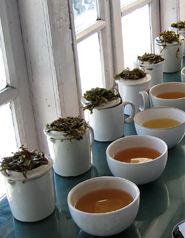 |
|
Tasting tea is not unlike tasting wine. There are many nuances in appearance, aroma and flavor to be considered when one is trying to discern quality in a particular varietal. The key to an objective tasting is not to harbor preconceived notions about what you expect the tea to taste like, be open to what the tea actually presents to your senses. Also, it will be important to approach the tasting with a "scientific methodology" in mind. In other words, be sure to use precise measurements in regard to water temperature, steeping time and quantity of leaf (weight measurements are more accurate than volume measurements for tasting purposes).
This way you will be comparing "apples to apples" when judging the quality difference between several First Flush Darjeelings, for example, if each sample is measured and prepared identically to the others.
Often times it is best to reduce your observations to writing as you taste each tea. This practice seems to force one to give careful thought to the teas characteristics, plus it gives you a journal to refer back to should your memory or palate become muddled in the midst of the tasting.
|



